
America’s leading Turf writer continues his hugely popular series with the ex-South American mare who took the US racing world by storm at the turn of the century
Sometimes the great ones take their time. They sneak up on you, one moment a familiar part of the Thoroughbred chorus, then suddenly alone on center stage, demanding the spotlight, stealing the show.
Riboletta came to the United States with enough of a reputation to think she might be the next Bayakoa, or Paseana, South American mares who ended up with multiple Eclipse Awards and a place in the racing Hall of Fame. She was a tall, aristocratic specimen – more handsome than pretty – with a deep mahogany coat, black mane and tail, and clean brown face without the fuss of a star or blaze.
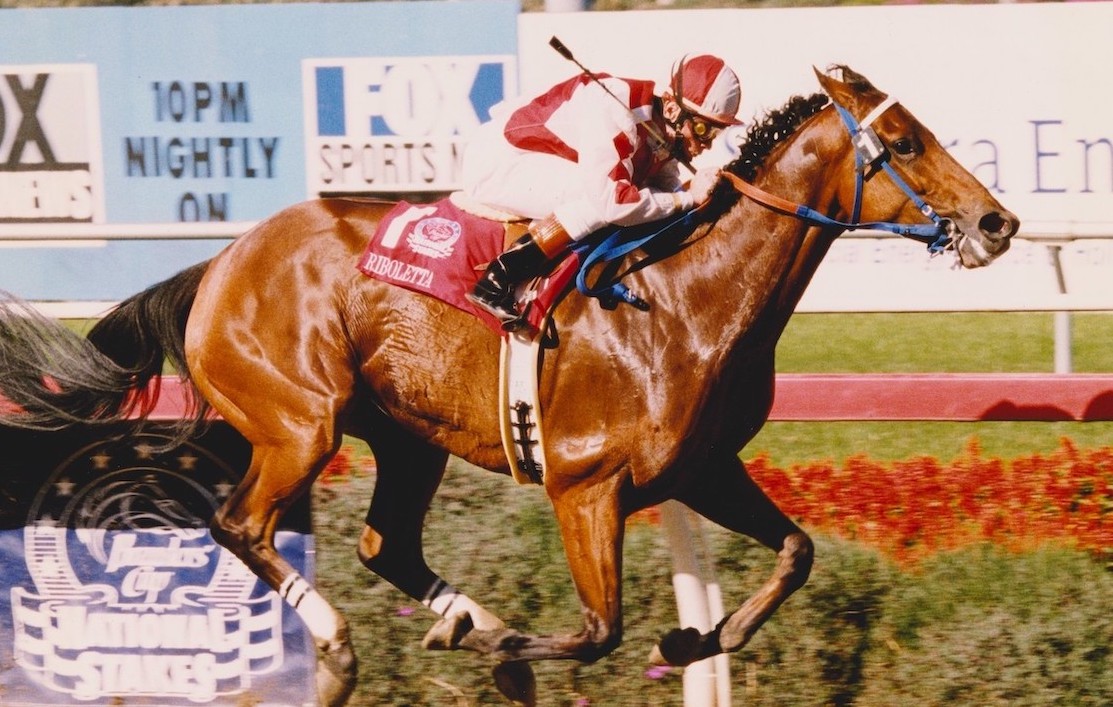 “She was beautiful and she loved to run,” said Marie Jones, who owned Riboletta with her husband, Aaron U. Jones. “She truly loved the competition.”
“She was beautiful and she loved to run,” said Marie Jones, who owned Riboletta with her husband, Aaron U. Jones. “She truly loved the competition.”
Riboletta was also a sweetheart who would come when you called and was glad for the company. The Joneses were accustomed to close contact with their runners, and Riboletta more than obliged.
Keeping the faith
Despite a frustrating debut season Stateside, they kept the faith and were rewarded with a national campaign at the dawn of the 21st century that would be ranked among the greatest single seasons in memory.
As with so many South American stars, Riboletta’s pedigree did not call attention to itself. Her sire, Roi Normand, was a product of Paul de Moussac’s Haras du Mezeray, Kentucky division, and a son of the very American stallion Exclusive Native, sire of Affirmed and Genuine Risk, among many other major stakes winners. The lineage cried out for a dirt career, but Roi Normand’s French female family intervened, bolstered by champion sire Luthier.
After a brief racing stint in France, Roi Normand was purchased by Californians Edmund and Bernice Gann on the recommendation of Bobby Frankel, who kept their new purchase on the turf to win a small stakes in Louisiana and then the G1 Sunset Handicap at Hollywood Park. He retired after one start in 1989.
Finding no interest among US breeders for their stallion, the Ganns sold Roi Normand to Haras Santa Ana do Rio Grande in the south of Brazil.
There, he established a successful reign as a five-time champion sire before his death in 2007, gaining notoriety not only for the performance of his domestic runners, but also for such exports as Redattore, a winner of seven graded stakes on both turf and dirt in California, and Riboletta, his favored daughter.
Joy Valley, the dam of Riboletta, had a brief stint as a racehorse before embarking on a broodmare career that also produced the Del Mar stakes winner Tamara Princess. A Brazilian foal of 1989, Joy Valley traces to Mistress Ford, the French filly who had a stranglehold on her generation in 1935-36, winning eight of nine starts while defeating colts in the Grand Criterium at two and taking the Prix de Diane and Prix Vermeille at three.
Riboletta’s pedigree sports a five-generation outcross. It would be six were it not for the appearance of superstar Djebel – winner of the wartime Arc de Triomphe of 1942 – in the fourth generation of Luth de Saron, the dam of Roi Normand.
Brazilian beginning
Whatever vigor such a wide array of influences provided was put to good use by Riboletta, who won the Grande Premio Diana (aka the Brazilian Oaks) on the grass at Cidade Jardim in Sao Paolo, in October 1998, and followed that in short order with a G3 win at Gavea racecourse on dirt.
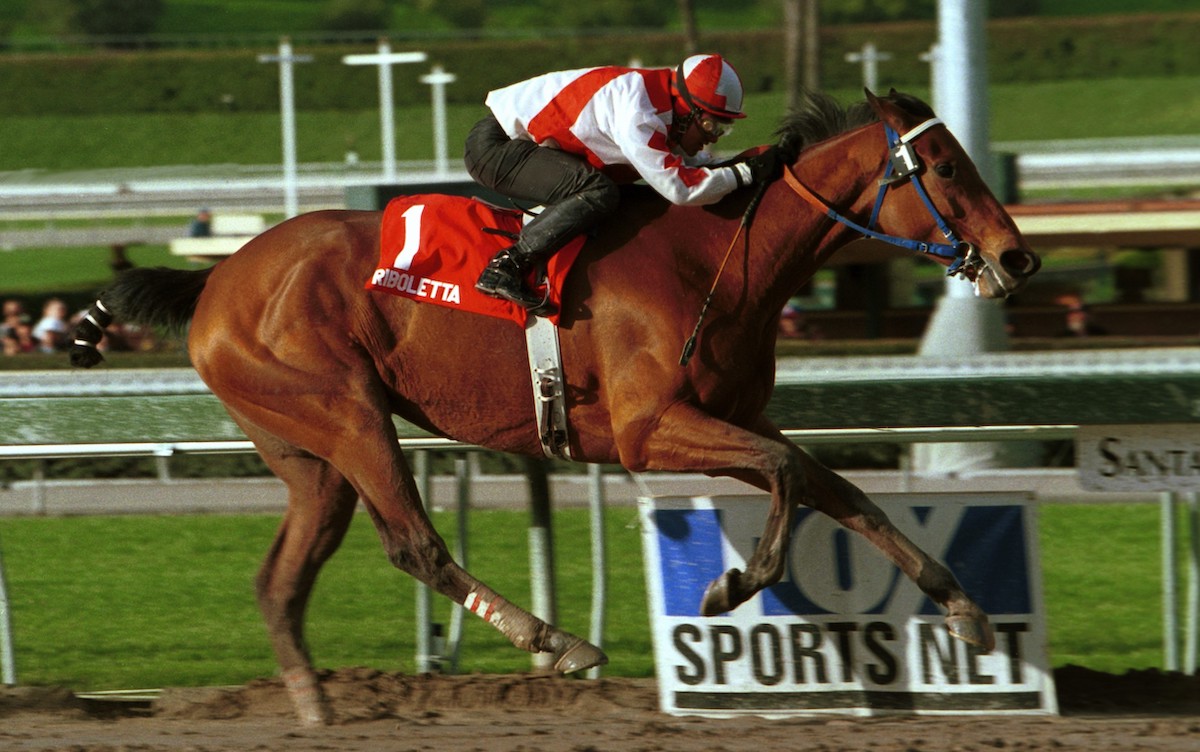
Unfortunately, she arrived with a minor injury to a hind foot – reportedly sustained while loading for the trip – so it was not until the Del Mar meet opened in late July 1999 that Riboletta began her US campaign in the restricted Osunitas Handicap on the grass. She finished fifth.
In six starts for Baffert, four of them on grass, the best Riboletta could do was win an allowance race and finish third in the Bayakoa Handicap at Hollywood Park. Soon after that race, Aaron Jones switched Riboletta – along with several other horses – to the stable of Eduardo Inda, who was a known quantity thanks to more than two decades serving as top assistant to Hall of Fame trainer Ron McAnally.
Inda landed in California in 1961 along with a shipment of horses from his native Chile, purchased by Clement Hirsch and headed for the barn of Warren Stute. After 10 years with Stute – during which the stable was blessed with major stakes winners Figonero and June Darling – Inda signed on with McAnally for an intoxicating run of major stakes action.
The leading light was, of course, John Henry, the two-time Horse of the Year and winner of more than $6.5 million in prize money. With McAnally attracting prime clients left and right, Inda had the good fortune to work with some of the top horses of the era, many of them imported from South American countries.
South American roots
Inda was 52 when went on his own in 1995 and had immediate success with such major stakes-winning mares as Borodislew, Toga Toga Toga, and India Divina. When Aaron Jones split from Baffert, the owner thought immediately of Inda, whose South American roots figured to be a perfect match for Riboletta.
“Way back when Laz Barrera trained for me, he said, ‘If you ever get a chance to use Eduardo Inda, he’s one of the best in the business,’” Jones noted at the time. “He understands these South American horses.”
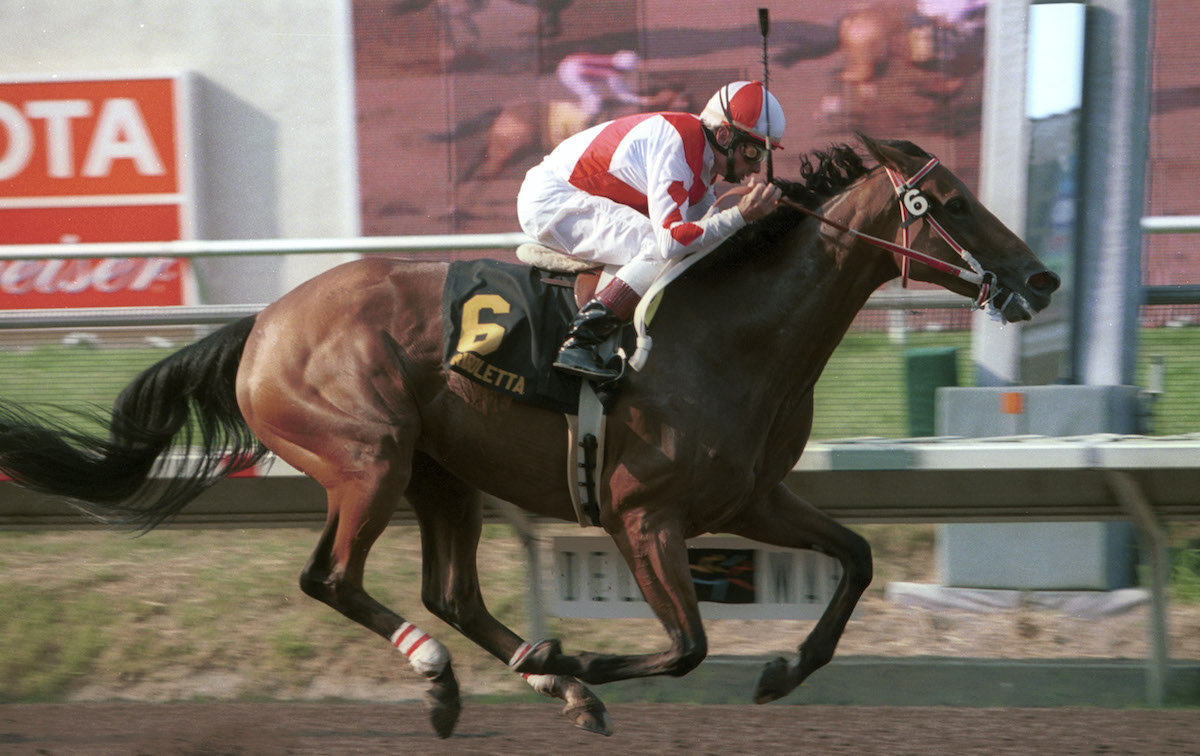 Aaron and Marie Jones dove head first into the Thoroughbred business in the early 1970s, not long after their marriage. As the story goes, Jones was told by his doctor to choose a diversion that would reduce the stress of his working world, which was centered around his Seneca Sawmill Co. in Eugene, Oregon. The Seneca operation was becoming widely known as a leading producer of quality building lumber, thanks to milling efficiencies pioneered by Jones.
Aaron and Marie Jones dove head first into the Thoroughbred business in the early 1970s, not long after their marriage. As the story goes, Jones was told by his doctor to choose a diversion that would reduce the stress of his working world, which was centered around his Seneca Sawmill Co. in Eugene, Oregon. The Seneca operation was becoming widely known as a leading producer of quality building lumber, thanks to milling efficiencies pioneered by Jones.
Soon, the Jones brand would make a mark in horse racing as well, thanks to such major stakes winners as Miss Musket, La Zanzara, and Valdez.
Lemhi Gold, winner of the 1982 Marlboro Cup and Jockey Club Gold Cup, was their first champion, followed in 1986 by Kentucky Oaks winner Tiffany Lass. In addition to Barrera, the best of the Jones runners were trained by Charlie Whittingham, then later by McAnally, Baffert, and Todd Pletcher.
In her first start for Inda, Riboletta finished a bang-up third in the San Gorgonio Handicap at Santa Anita, just behind turf aces Lady At Peace and Spanish Fern. Riboletta was compromised by a wet track in the subsequent Santa Maria Handicap, then bounced right back to take the prestigious Santa Margarita Handicap by three lengths.
For her next start, the Riboletta brain trust circled the Miss America Handicap on the grass at Golden Gate Fields. The purse was only $100,000 and the race was not a graded event, but it seemed to be easy pickings and an efficient way to keep the big mare happy on her schedule of racing once a month.
This did not account for her nervous reaction to a van ride from LA to San Francisco, however, nor did Riboletta seem to relish the footing over the Golden Gate course. She finished a distant third.
Display of dominance
Jones and Inda drew a line through that adventure and set a course through the rest of the summer. What ensued was a display of dominance by a West Coast mare echoed in subsequent years only by the likes of Azeri and Zenyatta.
One by one the races fell: the Hawthorne Handicap by seven lengths, the Milady Handicap by 3¼ lengths, the Vanity Handicap by 5½ lengths (while giving 15 pounds to the runner-up) at Hollywood Park, and finally the Clement L. Hirsch Handicap at Del Mar by a length and a half.
In each race, Riboletta was generous with the supporting cast, allowing others to set the early pace while she stalked close at hand. Her winning move in the upper stretch became as reliable as the dawn, and the contest was over by the time the furlong pole arrived.
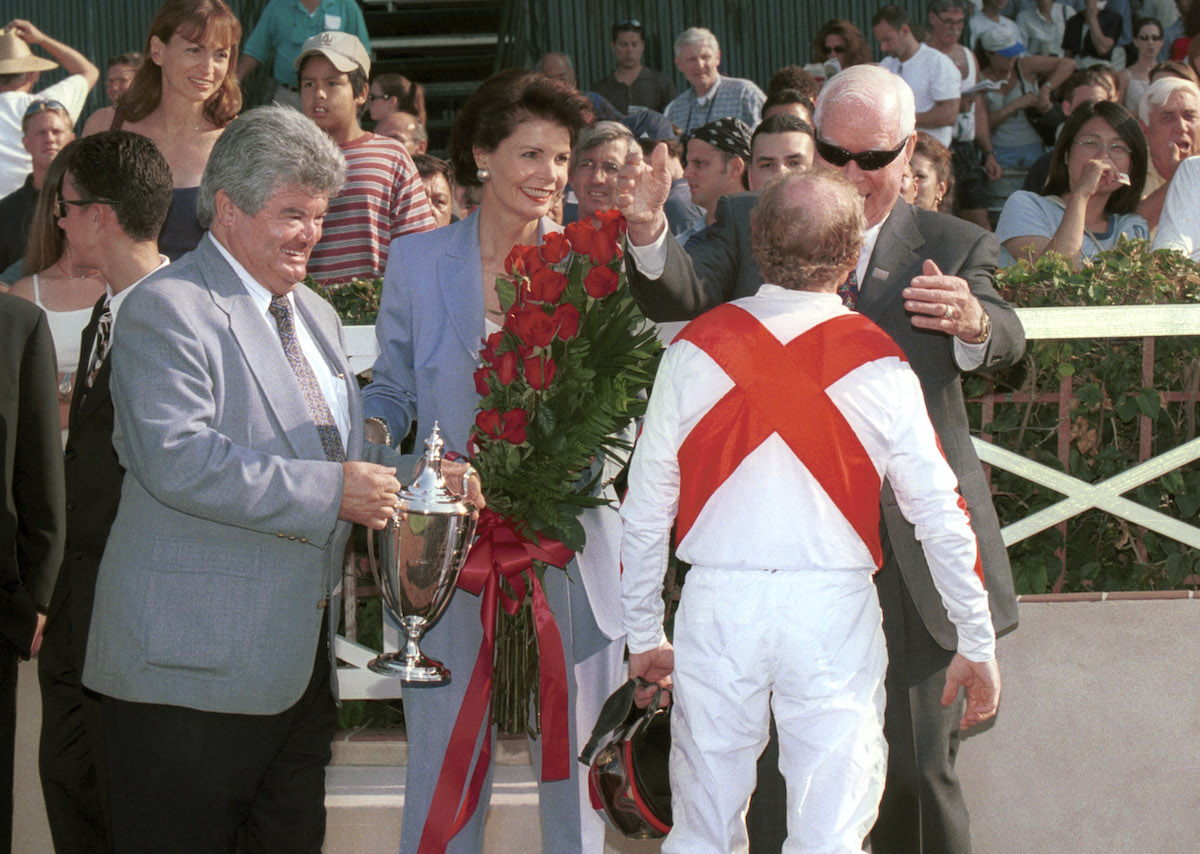 It is no surprise that Riboletta’s reign of dominance commenced with the addition of Chris McCarron to her equipment.
It is no surprise that Riboletta’s reign of dominance commenced with the addition of Chris McCarron to her equipment.
She had six different riders prior to the Hawthorne, when McCarron took over. He had just turned 45, secure in racing history after a Hall of Fame career of more than 6,900 winners and mount earnings of $230m. His gallery of champions included Alysheba, John Henry, Sunday Silence, Flawlessly, Precisionist and Belmont Stakes winners Touch Gold and Danzig Connection.
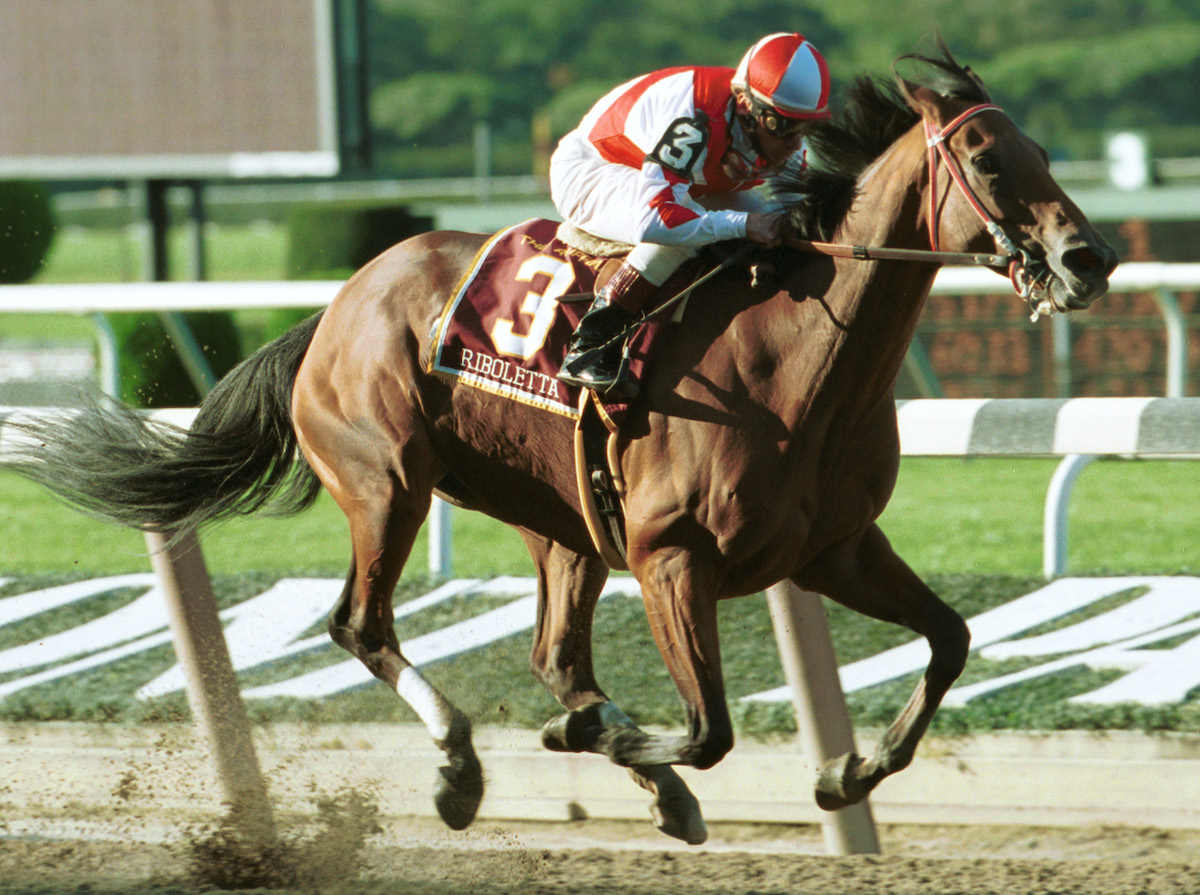 Later that summer, McCarron would be introduced to an upwardly mobile three-year-old colt named Tiznow, with more history in store. But first came Riboletta, a gift from the Joneses that brought back fond memories.
Later that summer, McCarron would be introduced to an upwardly mobile three-year-old colt named Tiznow, with more history in store. But first came Riboletta, a gift from the Joneses that brought back fond memories.
“I went back to New York in 1981 going for the national championship,” McCarron recalled. “While I was there I rode a colt named A Run to win the Nashua Stakes at Aqueduct for Aaron and Marie – a play on Aaron’s name.”
The following year, McCarron was aboard Lemhi Gold for victories in the Sword Dancer Handicap and Jockey Club Gold Cup. Riboletta provided his last and most successful collaboration with the owners.
Long, beautiful stride
“She had a big, long, beautiful stride,” McCarron said. “Really covered a lot of ground. She was a gem to ride, because she had speed, but she didn’t have to be in front. And she was a weight carrier, too, winning a couple of her races under 125 pounds, giving away as much as 16 pounds in her race at Del Mar.”
After winning the Hirsch, Jones and Inda decided there were greater hills for Riboletta to climb.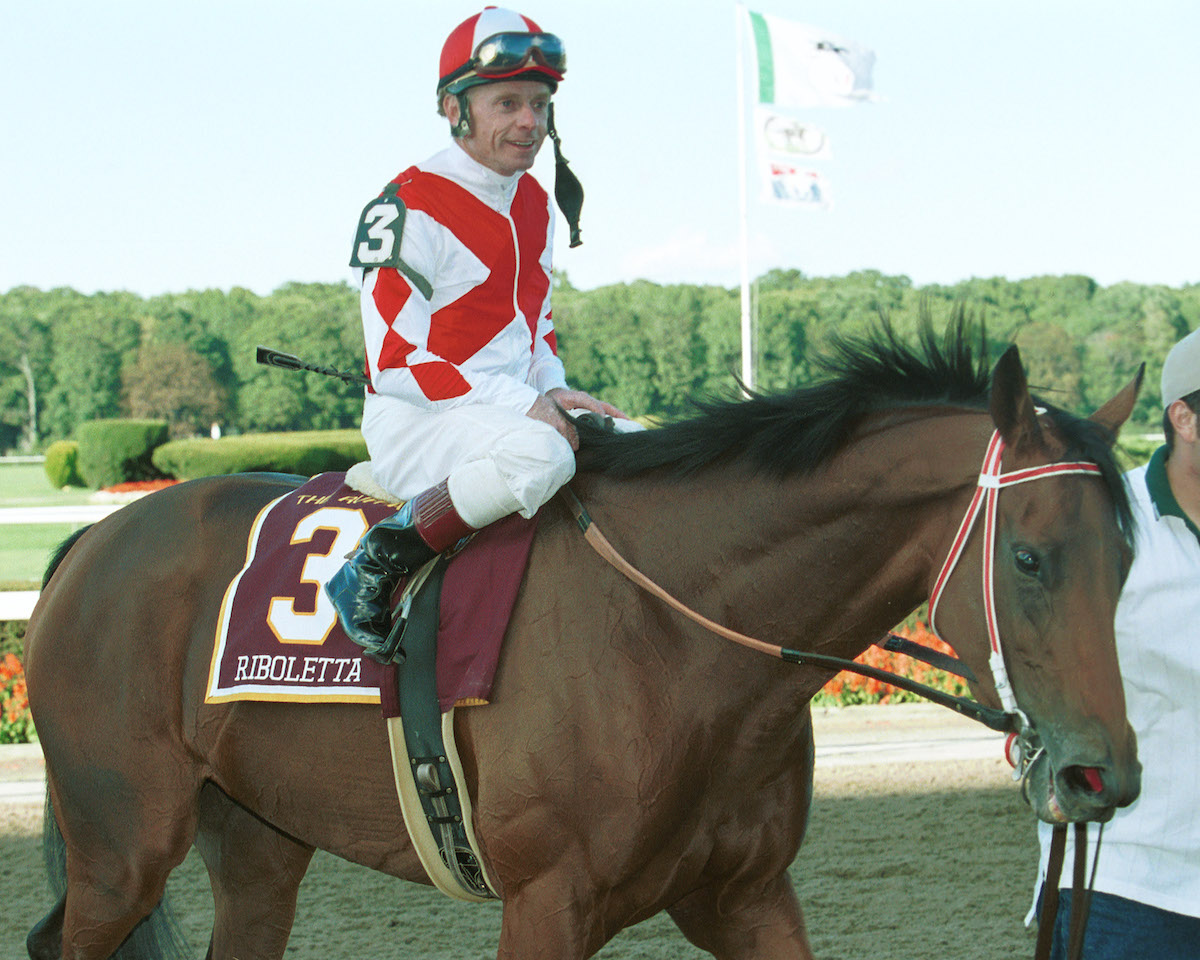
“Jonesy would always sit down and look at everything before making a decision,” Marie Jones said from her home in Eugene, Ore. “He’d look at the other horses and study how our horses would do if we sent them somewhere.”
So, instead of spending one more race in Southern California, they headed to New York, where racing secretary Mike Lakow had 125 pounds waiting for Riboletta in the Ruffian Handicap on Sept. 16.
Riboletta and McCarron answered by turning the 8½ furlongs into a parade, idling for a while on the lead with the quality Phipps filly Country Hideaway before sailing away in the Belmont Park stretch to win by 7½ lengths.
Still, East Coast skeptics needed to see more. Even the most dominant runners from the West still were suspect, especially over the sandy Belmont main track. The Beldame Stakes of Oct. 14 would provide Riboletta with the ultimate test of her emerging dominance, because waiting for her would be the champ herself – Beautiful Pleasure.
At age four in 1999, Beautiful Pleasure had swept to late-season victories in the Personal Ensign Handicap, the Beldame, and the Breeders’ Cup Distaff to earn the Eclipse Award for her division.
The daughter of Maudlin picked up in 2000 where she left off in New York, taking the Shuvee Handicap, Hempstead Handicap, and another Personal Ensign, while just missing in the Go For Wand Handicap. There were five entered for the 2000 Beldame, but at level weights, the nine-furlong event had the look of an old-fashioned match race.
“I did consider it a match race,” McCarron said. “And on the backside, when that other mare got away from me, I thought I was making a big mistake for not pressing my mare to try to keep up with Beautiful Pleasure. In a match race, the winner usually ends up being the fastest horse that tires the least.”
Out of the picture
After a half a mile in a brisk-but-realistic 46 seconds, down the long Belmont backstretch, Jorge Chavez and Beautiful Pleasure were gliding along half-a-dozen lengths ahead of Riboletta. The other three in the field were out of the picture.
“We began to dig into that margin around the turn,” McCarron went on, “and I was prepared for Beautiful Pleasure to give us a real fight in the stretch. But Riboletta went on by her pretty easily.”
The winning margin was two lengths, and with that Riboletta had essentially ended the conversation about the best mare in the land. There seemed to be nothing left for her to do other than show up at Churchill Downs for the Breeders’ Cup Distaff on Nov. 4, 2000, and accept her crown.
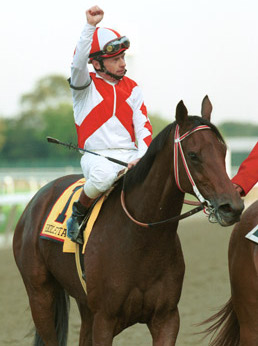 First, however, the Joneses had to swallow a Breeders’ Cup nomination penalty of $400,000, a ridiculous gamble, since the advertised winner’s purse of the Distaff was $1.2m, and finishing second would amount to breaking even.
First, however, the Joneses had to swallow a Breeders’ Cup nomination penalty of $400,000, a ridiculous gamble, since the advertised winner’s purse of the Distaff was $1.2m, and finishing second would amount to breaking even.
True enough, it had been nine months and seven starts since Riboletta had lost a race on the main track, and her championship was assured. But there was speculation that victory in the Distaff could put her in the thick of the conversation for Horse of the Year, since the older males of 2000 were a modest bunch, and the three-year-olds had no standout leader.
In the end, Aaron Jones paid the fee because, in his words, “After the great job Eduardo has done, he deserves a chance to run the mare in this race.”
At 40 cents on the dollar, Riboletta was the heaviest favorite of the eight races on that Breeders’ Cup program. According to McCarron, all signals were go from his vantage point as she warmed up and entered the gate.
Worrisome sight
Riboletta broke cleanly, as usual, but the shape of the early pace found her five paths wide around the first turn and onto the backstretch. Then, after barely half a mile had been run, McCarron was forced to ask Riboletta to hold her position in mid-pack, a worrisome sight.
From there it was a matter of how far she would be beaten by longshot Spain and her Wayne Lukas stablemate, Surfside.
“I was confounded,” McCarron said. “All I could think was that she just did not like the Churchill surface, which could happen with some horses. It was different than she’d faced before, but she had already handled Santa Anita, Hollywood Park, Del Mar, and Belmont Park with no problem.”
Upon her return to California, Inda and his veterinarians found that Riboletta had strained a suspensory ligament in her left-fore ankle. Jones announced her retirement, and his intention to breed the mare to his Storm Cat stallion, Forestry, who stood at Taylor Made Farm. By this time, the Joneses also had acquired Riboletta’s dam, Joy Valley, and full sister, Tamara Princess, making for a true family reunion.
The celebration continued with the announcement that Riboletta was the overwhelming choice as champion Older Female of 2000, at the Eclipse Award ceremonies in New Orleans.
But like so many Kentucky mares during that breeding season of 2001, Riboletta fell victim to the reproductive loss syndrome ravaging the farms and aborted the foal.
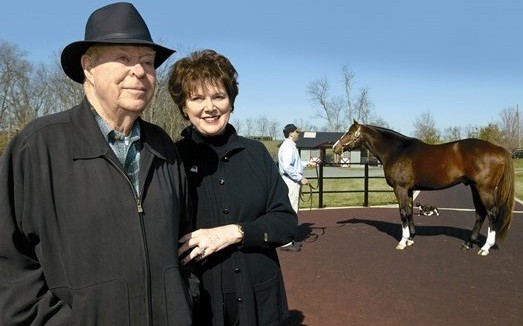 Worst time of my life
Worst time of my life
“It was the worst time of my life,” said Frank Taylor, who ran Taylor Made with his family. “At one point we lost 90 foetuses and eight foals. Sadly, Riboletta was among the affected mares.”
Once Jones was assured his mare was sound and fully recovered, he decided to put Riboletta back in training. The move did not work out, however, and in 2002 she was bred again to Forestry. This time she carried to full term and produced a filly they named Eternity.
Aaron Jones died in 2014, at 92, leaving behind a robust legacy that has been carried on by Marie Jones, who continues to breed and sell in association with Taylor Made. Eduardo Inda went on to enjoy success with the ace grass horse T.H. Approval, a two-time winner of the San Juan Capistrano Handicap at Santa Anita, before his retirement in 2012. Inda died in 2021.
As for Riboletta, she never produced an offspring remotely in her class, something she has in common with such formidable champion mares as Cicada, Gallant Bloom, Gamely, Genuine Risk, and Zenyatta. After a few foals for the Joneses, Riboletta she was sold privately to Darley America, but still had no luck.
“She had some reproductive issues, so she lived out the last five or six years with a bunch of our retired mares, then we had to put her down about three years ago,” said Dan Pride, CEO of Godolphin USA. “She was a very special mare, and we were proud to have her.”
• Read all Jay Hovdey's features in his Favorite Racehorses series
Best Pal: ‘If there ever was a word to describe him, ‘honest’ would top the list’
Hill Rise: ‘He is why I’m here, still writing about horses half a century after he was born’
Smarty Jones: ‘You know, this is America’s horse!’
View the latest TRC Global Rankings for horses / jockeys / trainers / sires


